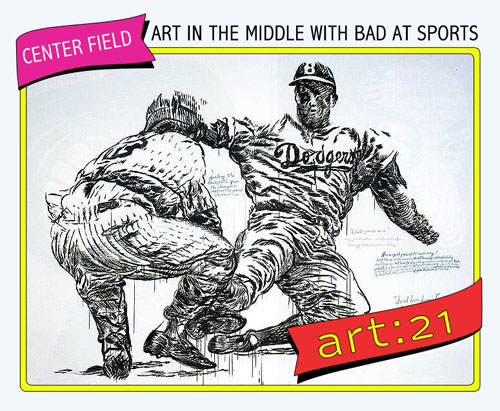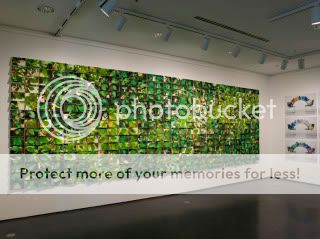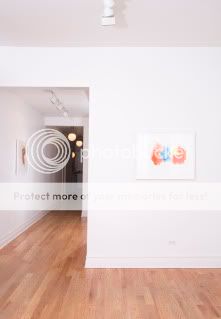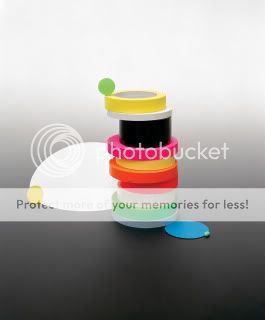
"Raymond Pettibon" 1999-2000. Installation view at the Museum of Contemporary Art, Los Angeles. Photo by Joshua White. Courtesy Regen Projects, Los Angeles.
Art21 is proud to present another new column, Center Field | Art in the Middle with Bad at Sports.
Since 2005, Bad at Sports’s podcast and blog have acted as a guide to the Chicago art scene through interviews and editorials with artists and cultural practitioners. With Center Field | Art in the Middle with Bad at Sports, the team hopes to do the same for Art21’s readers. Every other week on Tuesdays, we’ll show you a different aspect of the city’s art scene through interviews, profiles, reviews and editorial pieces written by members of the BaS collective: Meg Onli, Claudine Ise, Duncan MacKenzie, and Richard Holland.
Bad at Sports is a weekly podcast and daily blog produced in Chicago that features artists, arts writers, curators and other cultural practitioners talking about art and the community that participates in it. Founded in 2005 as a podcast by Duncan MacKenzie and Richard Holland, the website has been expanded to include a blog, overseen by Meg Onli and Claudine Ise, that features news, interviews, editorials, and reviews. With its primary hub in Chicago, BaS is the midwest’s most trafficked art blog, while the podcast has grown to become international in scope, thanks to contributors stationed in San Francisco, New York City, London, and Zurich. BaS’s archive currently holds over 230 hours of audio interviews with arts professionals, while the blog contains hundreds of reviews and editorial essays on the subject of contemporary art in Chicago and beyond. — Ed.
###
Welcome to Center Field | Art in the Middle with Bad at Sports, where every other Tuesday we give a little insight into the Chicago art scene. For our debut post, we speak with the director of Chicago gallery GOLDEN, Jacob Meehan.
Starting with his gallery’s inaugural exhibition, Psychodrama, by photographer Jill Frank in the Fall of 2008, Jacob Meehan of GOLDEN has shown a definitive eye for compelling work. With shows by both emerging and mid-career artists like Aspen Mays, Doug Ischar, and Pamela Fraser, GOLDEN has quickly established itself as one of Chicago’s most interesting new venues for contemporary art. Located in a residential building in the heart of Chicago’s predominantly gay neighborhood known as Boystown, GOLDEN combines the energy of an alternative apartment space with the professionalism of a commercial art gallery.
In the following conversation, Jacob and I discuss how GOLDEN utilizes its apartment showroom, the history of its neighborhood and how this relates to some of the work it has shown, as well as some of the artists that have exhibited in the space.
Meg Onli: There has been a lot of press covering the rise of apartment galleries in New York City. Chicago has had a very rich alternative/apartment gallery scene for years. GOLDEN, however, is a commercial gallery that uses an apartment as a showroom. Could you talk about how you utilize your space and discuss how you try to distinguish yourself from an apartment gallery?
Jacob Meehan: The showroom of our gallery occupies the entire first floor of a 120+ year old graystone, nestled on a landmarked avenue between Chicago’s Wrigleyville and Boystown neighborhoods. So what would be a generous two-bedroom apartment has been converted into a contemporary art gallery. At first, I was worried that people were going to hate the fact that it wasn’t a massive white cube, but it has proven to be a great space for showing work. The segmentation from the various rooms is actually an asset because it allows us to play with pace and rhythm.
I don’t mind being deemed an apartment gallery because we are a gallery in an apartment, but the notion of an apartment gallery usually brings up thoughts of artist-run types of spaces. I’m not actively trying to distinguish our space from those types of ventures, because those places are important and necessary. I think that what we’re doing is (unknowingly) from a more European model. I was in Milan last month (my first trip to Europe, proper) with my boyfriend, Henry, and the first gallery that we went to was, to our surprise, exactly like GOLDEN…and this space (Studio Guenzani) shows artists like Cindy Sherman, Catherine Opie, and Laura Owens. Unlike traditional apartment spaces, we are concerned with exhibiting, but furthermore, representing some of the best talent that is out there right now.
MO: You bring up an excellent point. It is often an oversight that many European galleries function under this model. Barbara Gladstone even has a gallery in Brussels that still has fireplaces in it. Any thoughts on why alternative/apartment spaces have garnered press recently?
JM: I think the basic issue is that in [this] economic climate, people who love art and have a curatorial eye want to do shows in any (and the best) form possible. The white cube doesn’t preclude a magnificent curatorial taste or necessarily ensure the best situation between artist, collector, and gallerist. Moreover, everyone starts from somewhere–Daniel Reich’s first show comes to mind.
MO: GOLDEN is located in the heart of Chicago’s Boystown. How did you decide to open a gallery that is, for the most part, pretty removed from the city’s two main gallery districts (the West Loop and Gold Coast)?
JM: This neighborhood is where Henry and I work and live, and we love it here. Both of us had the idea to open a gallery in our neighborhood around the exact same time, in the Summer of 2007. East Lakeview is not one of Chicago’s gallery districts, but it is pretty centrally located, and you don’t have to twist too many people’s arms to get them to hang out here. It is a totally viable neighborhood, one of the most populous in Chicago. It’ll be interesting to see if any other galleries decide to open up shop in these parts and what type of synergy that might spark.
MO: When I saw Doug Ischar’s show, Marginal Waters, I thought a lot about Boystown as a historical site for queerness. The photographs were shot literally within walking distance from the gallery. Obviously not all of your shows can have a similar connection, but could you go into detail about the work and the significance between the show and the neighborhood?
JM: Our season opener this past September was Doug Ischar’s Marginal Waters. This was a project that Ischar photographed back in 1985 during the height of the AIDS crisis. Ischar was a budding young photographer back then. He had just quit his tenured symphony job and moved here from San Francisco (it was a pre-Cal Arts MFA program for him), and he spent the entire summer documenting gay men socializing and recreating at the Belmont Rocks (Chicago’s then gay beach). It is an amazing project…so beautiful, so casual, and sometimes sexy. The photos are exactly what you think they wouldn’t be, considering when they were taken. The significance of the show was further compounded by the fact that Ischar had never shown this body of work before in its entirety, and it was being exhibited blocks away from the original location. It was a really important show for us. It was the beginning of our second year, and I think that it allowed people in the neighborhood to come through our doors and get better acquainted with us as a space. We’ve never had such a successful, well-attended show.
MO: There is a very diverse group of artists that have shown at GOLDEN, many of which have received a lot of national attention. How do you choose the artists? Are there themes you find yourself attracted to?
JM: Good question. For the most part, it is a highly intuitive and unforced process. We highly regard working closely with people that we like, trust, and respect. In general, I think that we gravitate towards work that is formally compelling and seductive in materials. Works must have that perfect balance between concept and craft. We want to invite viewers in and allow them to have a relationship with the work–and not leave them feeling totally high and dry. A lot of the work that we show, whether up-and-coming or more established, is capable of relating to a wider audience, but when it is time to throw it on the grill, it can hold its own within the greater history of artmaking.

Aspen Mays, "Every leaf on a tree," installation shot at the Museum of Contemporary Art Chicago's 12x12 gallery. On view February 6-28, 2010. Photography © Museum of Contemporary Art, Chicago Photographer, Nathan Keay Courtesy of the artist, MCA Chicago, and GOLDEN.
Take, for example, the work of our artist Aspen Mays. Mays makes conceptually challenging work that is rooted in curiosity about the natural world and mystery within the human experience, which is best illustrated by a photograph of hers that was made by putting fireflies in her camera to expose the film. At first glance, the piece seems like a very formal color field, but then the title reveals the twist: Untitled (Fireflies inside the body of my camera, 8:37-8:39PM, June 26, 2008). Part of Mays’ recent 12×12 exhibition at the MCA was a massive photo installation that depicted “Every leaf on a tree.” Over 900 individual color photographs became an open invitation to experience a tree in a completely different way — all you see are the leaves and are left to wonder about what the whole tree looked like. I like that sense of an open invitation to the audience, of staying close to the common experience.
MO: You graduated from Loyola University with a degree in Communication and Visual Communication and are a practicing photographer. How has your work influenced the gallery? Have the artists you’ve shown had an influence on your own work?
JM: As a practicing photographer, it is nice to be able to use my experiences in order to relate to the artists that I work with. Knowing the process of making and creating allows me to be very upfront and honest when talking to artists about their work. My studies in Visual Communication have helped to round out my eye, whether it’s looking at paintings, laying out text on show postcards, or installing works on paper.
For now, I am pouring my effort and energy into getting our program out there. It is hard working 4+ jobs, one of which is an art job, and keeping an artistic practice afloat. I do not produce work at the rate that I once did, but I now have more courage to not work in such a literal/representational way. I’ve spent the last few years making social documentary work, and now I’m starting to think in more non-photo, non-representational terms.

Installation shot of Pamela Fraser's "Untitled (Double Orange)," 2009, at GOLDEN. Acrylic gouache on polypropylene. Paper size: 20 x 26 inches. Courtesy the artist, Casey Kaplan, and GOLDEN.
MO: I noticed when I moved to Chicago that many of the artists here wear multiple hats. You have artists running spaces, such as Shannon Stratton of threewalls and Caroline Picard of Green Lantern. You also have people like Michelle Grabner, who has an active studio practice, runs the Suburban, and reviews art for magazines. In our previous conversations, we talked a bit about labels. Do you feel the need to label yourself as an artist or curator or do you feel there is room to be both?
JM: This is all pretty new to me so, no, I’m not quick to label. Calling myself a curator feels so silly, but I’m finding that I’m actually really good at it. No labels though, I just want to do a good job.
MO: What events do you have coming up in the following months? I saw on your website that Jessica Labatte was going to be having a solo show, Lazy Shadows, at the end of April. I have had a chance to see some of the work and it appears to be a brief shift from some of her previous photographs.
The end of April is going to be really huge for us. We are participating in Art Chicago, and right after the fair opens on Friday the 30th, we have to book it down to the gallery for Jessica Labatte’s opening reception and catalog release. Labatte’s photographs are amazing and they just keep getting better, which is why we wanted to honor them in a publication. The new stuff isn’t as much of a departure as it is a honing in on certain ideas. Her recent investigations in perception and illusionism have definitely reached an entirely new level, but she continues to make beautiful formal compositions out of discarded consumer goods and dollar store items that result in colorful mind-bending forms.
After Lazy Shadows comes down, we open a show with London based artist, Lloyd Durling. When the 2010-11 season starts in September, you will find us exhibiting more artists from outside of Chicago. We’re really excited.

Jessica Labatte, "Circularity," 2009. Archival inkjet photograph, 20 x 24 in. Courtesy the artist and GOLDEN.
MO: It’s been almost ten years since you first moved to Chicago. Have you noticed any significant changes in the art scene?
JM: Again, this is all pretty new to me. When I first moved to Chicago and started attending Loyola, I didn’t know where I was going to end up. I came here from a Southern Illinois farm town of 2,500 (Roodhouse, IL). I was always interested in a ton of things, creative things, and I think that it makes sense that this is all culminating into my being in the art world, but I am in no way qualified to speak about the past ten years of the Chicago art scene. I do know this: it seems like there’s always a little bit of buzz about Chicago, no matter where you go. People know Chicago, and in recent years the buzz seems to reverberate more and more. People like Hamza Walker, Melanie Schiff, Doug Ischar, Jim Lutes, Iñigo Manglano-Ovalle, Pamela Fraser…they’re all adding to the buzz…it’s a great place to be.






Pingback: Center Field | Art in the Middle with Bad at Sports : Bad at Sports
Pingback: GOLDEN Interview « Death is the final separation of the sound from the picture track………….
Pingback: Center Feild | Archiving Soul : Bad at Sports